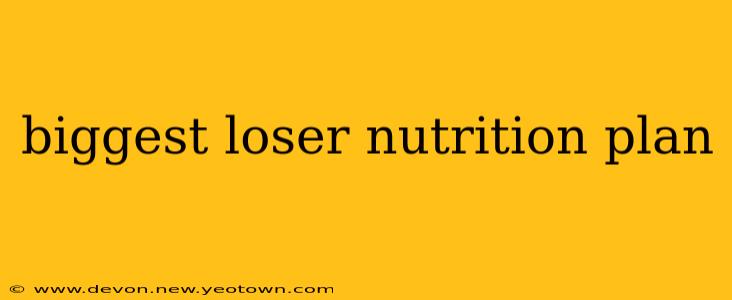The "Biggest Loser" TV show captivated audiences with its dramatic weight transformations. But behind the intense workouts and emotional journeys lay a carefully crafted nutrition plan. While the exact specifics varied across seasons, the core principles remained consistent: a balanced, calorie-controlled diet emphasizing whole, unprocessed foods. This wasn't a fad diet; it was a lifestyle change, focusing on sustainable habits for long-term success. Let's delve into the key elements that made the Biggest Loser nutrition plan effective, exploring what you can adapt for your own weight loss journey.
What is the Biggest Loser Diet Plan?
The Biggest Loser nutrition plan wasn't a single, rigid diet. Instead, it was a personalized approach guided by registered dietitians and nutritionists. The plan emphasized portion control, focusing on nutrient-dense foods to maximize satiety and minimize calorie intake. Think lean proteins, plenty of fruits and vegetables, and whole grains. Processed foods, sugary drinks, and unhealthy fats were largely restricted. The ultimate goal wasn't just weight loss; it was creating healthy eating habits that could be maintained long after the show ended.
What are the key components of the Biggest Loser Diet?
The cornerstone of the Biggest Loser's success lay in these key principles:
1. Calorie Deficit: Weight loss fundamentally boils down to burning more calories than you consume. The participants meticulously tracked their caloric intake, creating a deficit to promote fat loss. This was tailored to each individual's needs and activity levels, under strict medical supervision.
2. Macronutrient Balance: The plan focused on a balanced intake of macronutrients – proteins, carbohydrates, and fats. Lean protein sources were prioritized to support muscle mass retention during weight loss, while complex carbohydrates provided sustained energy. Healthy fats, like those found in avocados and nuts, were included in moderation to support overall health.
3. Whole Foods Emphasis: Processed foods, sugary drinks, and unhealthy fats were largely eliminated. The focus was on fresh fruits and vegetables, lean proteins (chicken breast, fish, beans), whole grains, and healthy fats. This ensured participants received a wide array of essential vitamins and minerals.
4. Portion Control: Learning to manage portion sizes was crucial. Participants learned to listen to their bodies' hunger and fullness cues, avoiding overeating. Using smaller plates and measuring food helped with this.
5. Hydration: Water intake was emphasized throughout the program. Water aids digestion, helps you feel full, and supports overall bodily functions.
What did the Biggest Loser contestants eat?
A typical day's meal plan might include:
- Breakfast: Oatmeal with berries and nuts, or a protein shake with fruit.
- Lunch: Salad with grilled chicken or fish, or a whole-wheat sandwich with lean protein and vegetables.
- Dinner: Baked salmon with roasted vegetables, or chicken stir-fry with brown rice.
- Snacks: Fruits, vegetables, nuts, or yogurt.
How many calories did the Biggest Loser contestants consume?
The exact caloric intake varied widely among contestants based on their individual needs, body composition, and activity levels. The plan wasn't about a strict number of calories, but about creating a sustainable and healthy calorie deficit under the guidance of professionals. Attempting to replicate the exact caloric restrictions without professional supervision is strongly discouraged.
Is the Biggest Loser diet healthy?
While the show's intense approach isn't necessarily sustainable for everyone, the underlying principles of a balanced diet, portion control, and regular exercise are undeniably healthy. The key takeaway isn't to mimic the extreme measures of the show, but to adapt its healthy eating principles to your own lifestyle. The show’s focus on whole, unprocessed foods and regular exercise are positive aspects that can be incorporated into a healthy lifestyle for long-term weight management.
Can I follow the Biggest Loser diet plan?
While you can't replicate the exact program without professional guidance, you can adapt its core principles. Focus on a balanced diet rich in whole foods, practice portion control, and engage in regular physical activity. Most importantly, consult with a registered dietitian or healthcare professional to create a personalized plan that suits your individual needs and health status. They can help you determine a safe and effective calorie deficit and ensure you're meeting all your nutritional requirements. Remember, sustainable weight loss is a journey, not a race.

